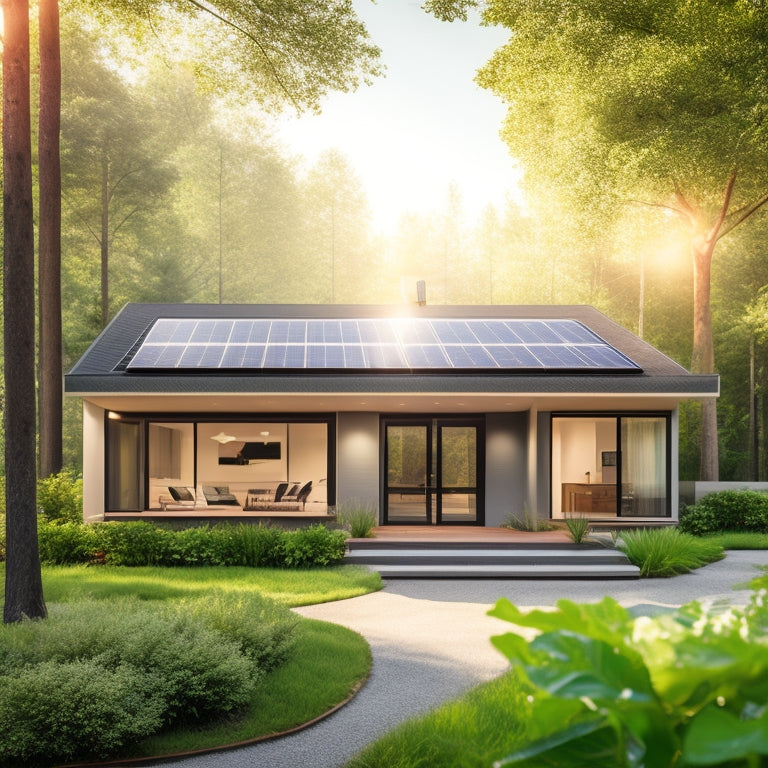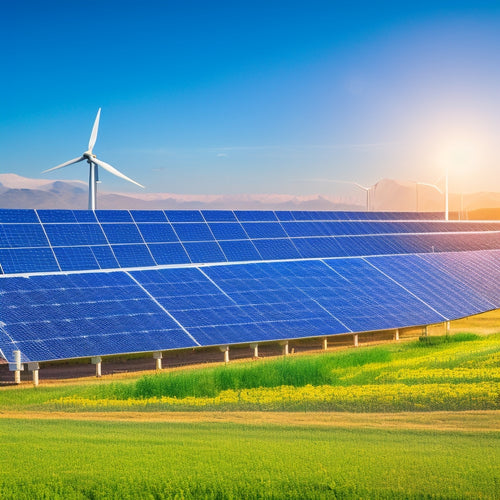
Calculate Home Energy Independence Costs Easily
Share
When calculating home energy independence costs, you'll need to contemplate multiple factors. Assess your energy needs by evaluating daily consumption patterns, identifying peak demand periods, and determining the necessary size of your renewable energy system. Next, calculate total system costs, including financing options, labor, and maintenance projections. Break down component prices, including solar panels, inverters, and battery storage. Don't forget to investigate incentives and rebates, as well as energy efficiency upgrades to reduce reliance on the grid. By understanding these complex factors, you'll get accurate cost estimates and move closer to achieving energy independence – and there's more to uncover about optimizing your expedition.
Overview
- Assess your energy usage patterns to determine the required solar panel system size and configuration for energy independence.
- Calculate total system costs, including financing options, labor, and maintenance projections, to understand the financial commitment.
- Evaluate the cost-effectiveness of different component prices, such as solar panels, inverters, and battery storage, to optimize your system.
- Identify energy-saving opportunities through energy audits and efficiency upgrades, such as insulation and smart technologies, to reduce your reliance on the grid.
- Research and take advantage of available incentives, such as federal tax credits and local utility rebates, to minimize out-of-pocket expenses and accelerate your shift to energy independence.
Understanding Solar Panel Costs
Your solar panel system's overall cost is an essential factor in determining the feasibility of moving to renewable energy.
You'll need to evaluate solar panel financing options, such as loans or leases, to fund your changeover. Installation alternatives, like rooftop or ground-mounted systems, also impact your upfront costs.
System size and complexity play a significant role in determining costs, as larger systems require more components and intricate system integration, raising costs exponentially system integration.
High-quality equipment from reputable suppliers guarantees reliability, durability, and performance, which is critical for peak system operation.
Don't forget to factor in maintenance costs, which can be minimal but are important for peak performance. Energy storage solutions, like batteries, can add to your overall expense.
Look for high-efficiency ratings to maximize your energy output. Government policies, market trends, and sustainability impact also influence your solar panel costs.
Factors Affecting System Pricing
Determining the overall cost of a solar panel system requires considering a multitude of factors that impact system pricing. You'll want to evaluate the system size, installation complexity, equipment quality, and maintenance expenses. Financing options, regional pricing, and technological advancements also play a significant role. Additionally, market trends, contractor selection, and warranty coverage can influence the final cost.
| Factor | Impact on System Pricing |
|---|---|
| System Size | Larger systems typically cost more, but economies of scale can reduce cost per watt |
| Installation Complexity | More complex installations (e.g., multiple roofs) increase labor costs |
| Equipment Quality | High-quality equipment may be more expensive, but provides better performance and durability |
Assessing Your Energy Needs
Before investing in a solar panel system, you need to get a clear view of your energy usage patterns to guarantee the system you install can meet your needs effectively. This involves evaluating your energy consumption, which is influenced by your lifestyle and energy efficiency habits.
Conducting an energy audit helps identify areas for improvement, allowing you to optimize your energy usage and reduce your reliance on non-renewable sources. To accurately calculate your daily energy consumption, consider calculating daily energy consumption in watt-hours (Wh) or kilowatt-hours (kWh) and multiply device wattage by operational hours to determine total consumption.
Reviewing your past utility bills provides significant data for cost comparisons and informs decisions on future upgrades. By understanding your energy needs, you can determine the ideal size and configuration of your solar panel system, ensuring a seamless shift to renewable energy and a significant step towards home energy independence.
Calculating Total System Costs
Economic viability is a crucial aspect of achieving home energy independence, and calculating total system costs is essential to ensuring a successful change.
You'll need to evaluate various factors, including system financing options, installation labor costs, and maintenance expense projections. As you crunch the numbers, think about how technology advancements can impact your costs. A long term savings analysis will help you understand the benefits of grid independence and the value of energy storage solutions.
For instance, the cost of solar panel efficiency can affect upfront costs, with more efficient panels yielding more power per hour of sunlight. Additionally, the type and quality of batteries, such as Lithium-Ion or Sodium-Ion, can also impact overall costs.
If you're contemplating a DIY installation, factor in the potential savings, but also weigh the risks. Additionally, conduct an environmental impact assessment to quantify the eco-friendly benefits of your system.
Breaking Down Component Prices
As you investigate the specifics of your home energy independence system, understanding the cost of each component becomes vital.
You'll need to evaluate the cost of solar panels, inverters, and battery storage, as well as installation costs, which can vary depending on local regulations and technology advancements.
Additionally, factor in maintenance expenses, which can be minimal but are significant for peak energy efficiency.
Financing options can help make your system more affordable, and it's important to measure these against the long-term savings and return on investment you'll gain from achieving grid independence.
Incentives and Rebate Opportunities
Taking advantage of incentives and rebate opportunities can considerably offset the upfront costs of your home energy independence system.
You can examine federal incentives, such as tax credits, and local rebates offered by your utility company or government. Some utility programs provide financing options or installation discounts for energy-efficient upgrades.
Additionally, you may be eligible for government grants or community programs that support renewable energy initiatives.
Research and take advantage of these opportunities to minimize your out-of-pocket expenses. By doing so, you can increase your return on investment in energy independence and accelerate your shift to a self-sustaining home.
Getting Accurate Cost Estimates
You'll need to assess your current energy use to understand your energy consumption patterns and identify areas where you can cut back.
Next, you'll want to identify energy-saving opportunities, such as upgrading to energy-efficient appliances or adding insulation, to determine how much energy you'll need to generate.
Assess Current Energy Use
To gain a clear understanding of your home's energy usage, begin by gathering data on your current energy consumption patterns. This will help you identify areas where energy conservation and efficiency upgrades can be made. Conducting an energy audit will provide significant perspectives into your usage patterns, consumption trends, and peak demands. This information will be essential in determining your reliance on the grid and potential for renewable options.
| Energy Category | Average Daily Consumption |
|---|---|
| Electricity | 30 kWh |
| Natural Gas | 50 therms |
| Water | 200 gallons |
| Heating Oil | 5 gallons |
| Propane | 10 gallons |
Identify Energy Saving Opportunities
With your current energy consumption patterns in hand, you're now ready to identify energy-saving opportunities that can help you achieve home energy independence.
Conduct an energy audit to pinpoint areas of inefficiency, and prioritize efficiency upgrades, such as insulation improvements and smart technologies.
Consider behavioral changes, like adjusting your thermostat or using energy-efficient appliances, to reduce consumption.
Analyze your utility rates and investigate renewable sources, like solar or wind power, to offset your energy needs.
A thorough home assessment will help you identify areas for improvement.
Perform a cost-benefit analysis to determine which upgrades will yield the greatest returns.
Determine System Requirements
Accurate cost estimates for achieving home energy independence hinge on determining the system requirements that meet your specific energy needs.
To do this, you'll need to assess your energy usage patterns, including your daily energy consumption and peak demand periods. This will help you determine the size and type of renewable energy system required to meet your needs.
Consider factors such as energy efficiency upgrades, like insulation and window replacements, to reduce your energy demand.
You'll also need to decide on battery storage capacity to guarantee a stable energy supply during periods of low energy production.
Frequently Asked Questions
Can I Install Solar Panels on My Own to Save Money?
You can attempt a DIY installation, but it's essential to weigh the risks: improper installation can lead to safety hazards, voided warranties, and reduced efficiency, potentially offsetting any cost savings you'd hoped to achieve.
How Long Does It Take to Install a Solar Panel System?
You'll need around 3-5 days for a typical residential solar panel installation, but the entire process, from assessment to commissioning, can take 2-6 months, depending on permits, inspections, and the complexity of your installation process overview.
Are Energy Storage Systems Compatible With Solar Panels?
You'll find that most energy storage systems seamlessly integrate with solar panels, optimizing energy storage compatibility and solar panel efficiency, allowing you to capture and store excess energy for maximum autonomy and freedom from grid reliance.
Can Solar Panels Generate Electricity During a Power Outage?
You might be surprised to learn that 70% of solar panels can't generate electricity during a power outage without additional equipment. However, with the right solar panel functionality and power outage solutions, like grid-tie inverters with backup capabilities, you can utilize clean energy even when the grid fails.
Will Solar Panels Increase My Property Value?
You'll likely see an increase in property value with a solar investment, as a property appraisal will reflect the increased worth, and studies show solar-equipped homes sell for more, giving you a stronger resale position.
Ready to Buy
By following these steps, you've deciphered the code to calculating home energy independence costs, like opening a treasure chest filled with savings. Now, you can confidently steer through the intricacies of solar panel pricing, factor in incentives, and pinpoint the perfect system for your energy needs. With this newfound clarity, you'll be well on your way to utilizing the power of the sun and reaping the financial rewards that come with it.
Related Posts
-

Smart Home Thermostats to Revolutionize Your Space
Smart home thermostats revolutionize your space by providing precise temperature control and optimizing energy saving...
-

The Role of Battery Monitoring Systems in Renewable Energy
Battery monitoring systems play an essential role in renewable energy by enhancing system longevity and optimizing pe...
-

Cost of Home Solar Battery
You're looking to invest in a home solar battery to reduce your grid reliance, but you're curious about the cost. The...


